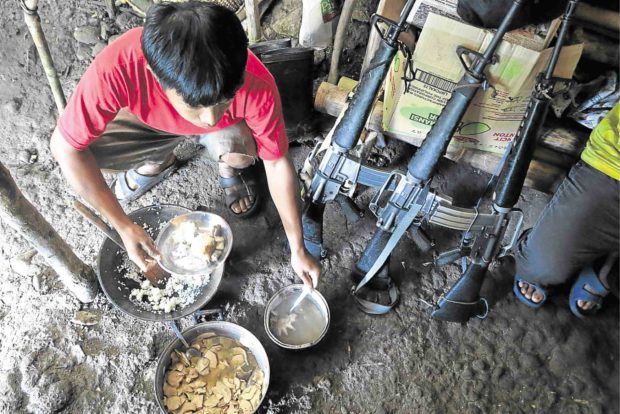
A communist rebel prepares food in a guerrilla camp somewhere in the Cordillera in this photo taken in 2013. —EV ESPIRITU
ALAMINOS CITY—It was in a remote upland village in this western Pangasinan city where the Communist Party of the Philippines (CPP) was born 49 years ago.
But as the CPP marks its anniversary on Dec. 26, there will be no celebration here, according to Danilo Ballesteros, 53, chief of Barangay Dulacac, where a congress to reestablish the CPP was held in 1968.
Bamboo hut
“I’ve been a [village chief] since 2007 but I do not know of an activity that was held here to celebrate the CPP’s founding anniversary,” Ballesteros said.
The new CPP was born in a hut near the house of the parents-in-law of Arthur Garcia, one of the CPP founders who died in 1969.
According to Jose Maria Sison, CPP founding chair, the founders did not use the house for the meeting but a smaller bamboo hut used for rest from farm work.
Sison said the founders commuted to Alaminos on a Pantranco bus from Metro Manila on Christmas Day. Two batches of CPP leaders arrived and walked from the bus terminal to the house in Dulacac.
They had chosen the place because it was safe, secluded and far from Metro Manila, Sison said in an earlier e-mail message.
Dulacac, which is a 30-minute uphill drive from the City Hall here, lies near the boundaries of this city and the towns of Bani and Mabini.
The two-story house Sison was referring to was demolished by the lot’s new owners, Ballesteros said.
Old folk in the village said they remembered the house as “a place often visited by strangers to the town.”
Strangers in town
“I don’t think the villagers knew then that those strangers were CPP members. Now we know,” Ballesteros said, adding that the event has made Barangay Dulacac part of history.
Former Mayor Hernani Braganza said he learned about the city’s historic ties to the CPP in 2001 when he served as agrarian reform secretary and as member of the government panel in peace talks with the CPP’s broader coalition, National Democratic Front of the Philippines.
It was Sison, Braganza said, who gave him the CPP back story at a meeting in the Netherlands, where the communist leader has been in exile since the late 1980s. The CPP’s origins were usually referred to as “somewhere between Central and Northern Luzon.”
Sison proposal
Sison had urged Braganza then to develop Dulacac into a tourist spot and reconstruct the hut where the CPP founding congress was held.
Although they did not see any threat to the founding place of the CPP, Supt. Benjamin Ariola, Alaminos police chief, said police were on full alert and have made themselves visible in Dulacac.
“Alaminos has long been an insurgency-free area. There were no sightings of the New People’s Army here and no activities that were initiated by communist rebels,” he said.